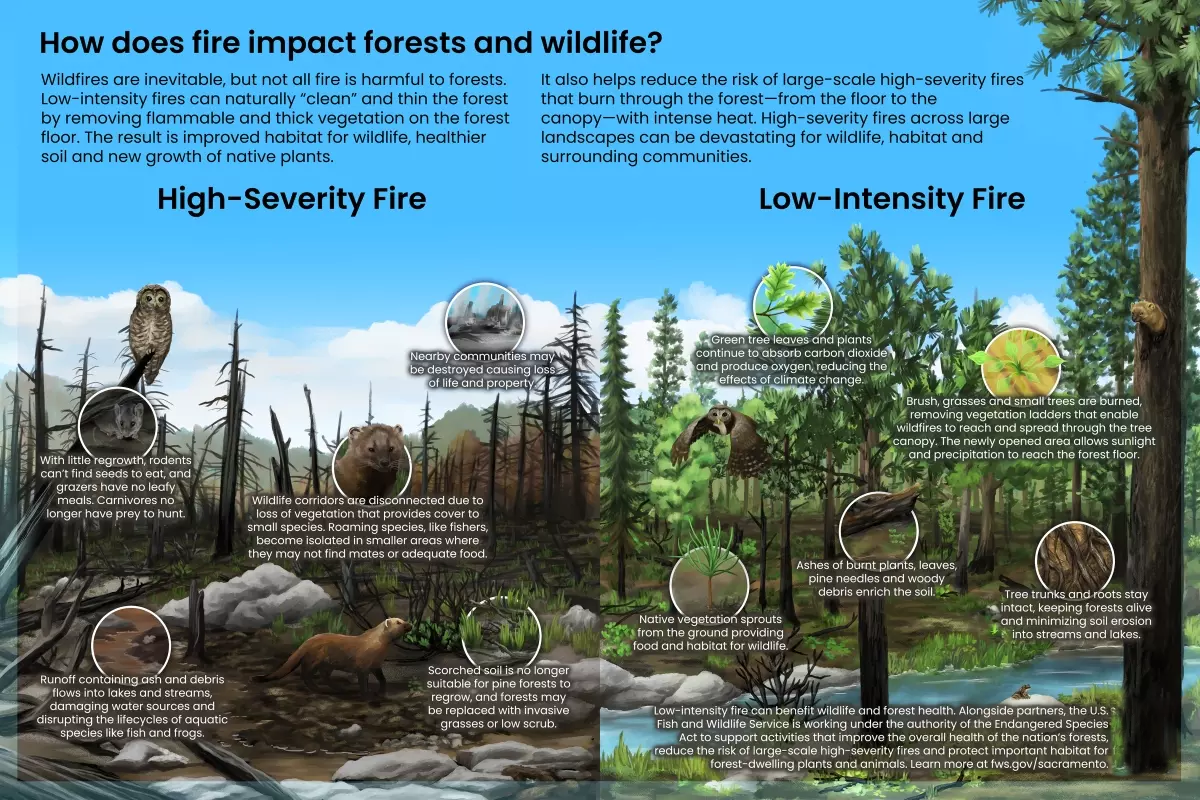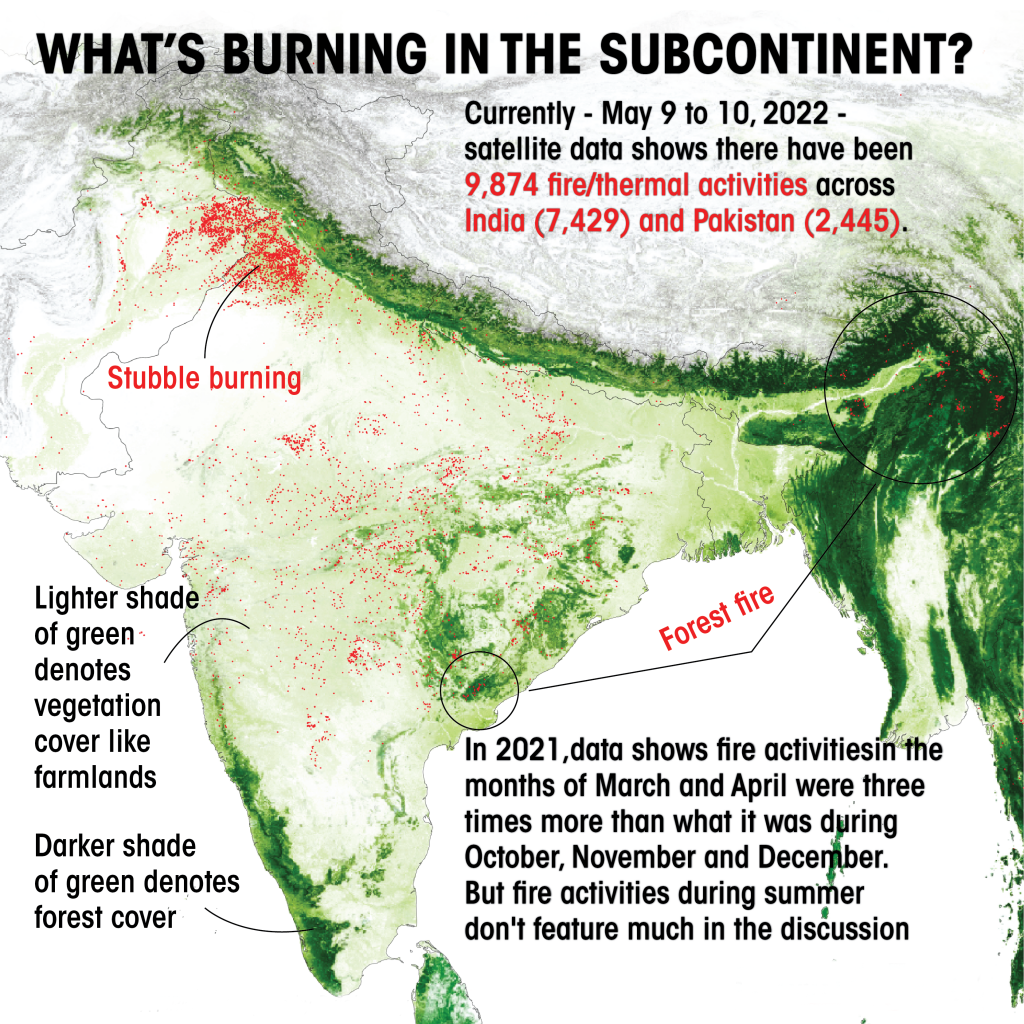Biodiversity & Environment
Forest Fires
- 20 Mar 2024
- 12 min read
For Prelims: Forest Fires, Bambi Bucket, India State of Forest Report (ISFR), Forest Survey of India (FSI), The Forest Fire Prevention and Management Scheme (FPM).
For Mains: Forest Fires, Environment Pollution and Degradation.
Why in News?
Recently, Forest Fires have been raging in the Coonoor forest range in the Nilgiris in Tamil Nadu.
- The Indian Air Force joined the ongoing firefighting efforts of the state forest department, deploying a Mi-17 V5 helicopter to conduct multiple “Bambi Bucket” operations.
Note
The Bambi Bucket, also called a helicopter bucket or a helibucket, is a specialised container that is suspended by cable under a chopper, and which can be filled by lowering into a river or pond before being flown above a fire and discharged aerially by opening a valve at the bottom of the bucket.
- The Bambi Bucket is especially helpful in fighting wildfires that are difficult or impossible to reach from the ground. Around the world, helicopters are frequently commissioned to fight forest fires.
What is a Forest Fire?
- About:
- Also called bush or vegetation fire or wildfire, it can be described as any uncontrolled and non-prescribed combustion or burning of plants in a natural setting such as a forest, grassland, brushland or tundra, which consumes the natural fuels and spreads based on environmental conditions (e.g., wind, topography).
- A wildfire requires three essential elements to sustain combustion like Fuel, Oxygen, and a Heat source.
- Classification:
- Surface Fire: A forest fire may burn primarily as a surface fire, spreading along the ground as the surface litter (senescent leaves and twigs and dry grasses etc) on the forest floor and is engulfed by the spreading flames.
- Underground Fire/Zombie Fire: The fires of low intensity, consuming the organic matter beneath and the surface litter of the forest floor are sub-grouped as underground fires. In most of the dense forests, a thick mantle of organic matter is found on top of the mineral soil.
- These fires usually spread entirely underground and burn for some meters below the surface.
- This fire spreads very slowly and in most cases it becomes very hard to detect and control such types of fires.
- They may continue to burn for months and destroy the vegetative cover of the soil.
- Canopy or Crown Fires: These occur when fire spreads through the upper canopy of trees, often fueled by high winds and dry conditions. They can be particularly intense and difficult to control.
- Controlled Deliberate Fires: In some cases, controlled deliberate fires, also known as prescribed burns or bushfires, are intentionally set by forest management agencies to reduce fuel loads, mitigate the risk of uncontrolled wildfires, and promote ecosystem health.
- These controlled burns are carefully planned and executed under specific conditions to minimize risks and maximize benefits to the forest ecosystem.
- Government Initiatives:
- National Action Plan for Forest Fires (NAPFF), was started in 2018 with the goal of reducing forest fires by informing, enabling, and empowering forest fringe communities and incentivizing them to collaborate with state forest departments.
- The Forest Fire Prevention and Management Scheme (FPM) is the only government-sponsored programme dedicated to assisting states in dealing with forest fires.
How Common are Forest Fires in India?
- Forest Fire Season:
- November to June is considered to be forest fire season in India, with hundreds of thousands of small and large fires burning every year, especially from February onward as summer approaches.
- April-May are usually the worst fire months across the country.
- The biennial India State of Forest Report (ISFR) published by the Forest Survey of India (FSI) in its 2021 report, shows that the total Fire-prone forest area is 35.47% of the forest cover.
- November to June is considered to be forest fire season in India, with hundreds of thousands of small and large fires burning every year, especially from February onward as summer approaches.
- Regions:
- Severe fires break out in dry deciduous forests, while evergreen, semi-evergreen, and montane temperate forests are comparatively less prone to fires.
- The forests of Northeast India, Odisha, Maharashtra, Jharkhand, Chhattisgarh, and Uttarakhand are the most vulnerable to fires during the November to June period.
- In 2021, a series of forest fires broke out in Uttarakhand, Himachal Pradesh, Nagaland-Manipur border, Odisha, Madhya Pradesh, and Gujarat, including in wildlife sanctuaries.
- Present Scenario (2024):
- The highest number of forest fires have been reported from Mizoram (3,738), Manipur (1,702), Assam (1,652), Meghalaya (1,252), and Maharashtra (1,215), as per FSI data.
- Satellite data of Indian Space Research Organisation (ISRO) tools, showed that forest fires have been on an uptick since early March 2024 along the Konkan belt in Maharashtra, south-coastal Gujarat along Gir Somnath and Porbandar, southern Rajasthan and adjoining south-western districts of Madhya Pradesh, coastal and interior Odisha, and adjoining Jharkhand.
- In South India, most forest-covered areas of Andhra Pradesh, Karnataka and Tamil Nadu have seen fire incidents over the past week.
What is the Reason for the Forest Fires?
- Human Carelessness:
- A majority of forest fires are caused by human activities such as discarded cigarettes, campfires, burning of debris, and other similar processes.
- With increasing urbanisation and human presence in forested areas, the risk of accidental fires also increases.
- Usually, poachers and illegal smugglers set fires either to divert the attention of forest officials or to eliminate evidence of their crimes.
- Weather Conditions:
- The exceptionally hot and dry weather conditions experienced in southern India, particularly during the early phase of the summer season, have created a conducive environment for the spread of forest fires.
- High temperatures, low humidity, and calm winds increase the likelihood of fires igniting and spreading rapidly.
- Aridity:
- Southern India has experienced above-normal temperatures, clear sky conditions, and a lack of rainfall, leading to increased aridity.
- This dries out vegetation, making it more susceptible to ignition and facilitating the rapid spread of fires.
- Early Availability of Dry Biomass:
- The above-normal temperatures experienced in the months leading up to the summer season have resulted in an early availability of dry biomass in forests.
- This dry vegetation, including the leaves of chir forests, is particularly prone to igniting and spreading fires.
- The high flammability of chir forest leaves raises the chances of forest fires and adds to their intensity and rapid spread.
What can be Done to Mitigate Forest Fire?
- Public Awareness and Education:
- Educating the public about the causes and consequences of forest fires, as well as promoting responsible behaviour in forests, can help reduce the incidence of human-caused fires.
- Campaigns on fire safety, proper disposal of cigarettes, and the dangers of leaving campfires unattended can raise awareness and encourage responsible behaviour.
- Strict Enforcement of Regulations:
- Enforcing laws and regulations related to forest fire prevention, such as restrictions on burning debris and campfire bans during dry periods, can help reduce the risk of accidental fires.
- Penalties for violating fire safety regulations should be strictly enforced to deter irresponsible behaviour.
- Enforcing laws and regulations related to forest fire prevention, such as restrictions on burning debris and campfire bans during dry periods, can help reduce the risk of accidental fires.
- Firebreaks and Fuel Management:
- Creating firebreaks and conducting controlled burns to remove excess vegetation can help reduce the spread of fires by creating barriers and reducing fuel loads.
- Proper fuel management practices, such as thinning dense vegetation and clearing deadwood, can also make forests more resilient to fires.
- Creating firebreaks and conducting controlled burns to remove excess vegetation can help reduce the spread of fires by creating barriers and reducing fuel loads.
- Early Detection Systems:
- Implementing early detection systems, such as surveillance cameras, satellite monitoring, and lookout towers, can help detect fires in their early stages when they are easier to contain.
- Rapid detection allows for a quicker response, minimizing the size and impact of fires.
- Implementing early detection systems, such as surveillance cameras, satellite monitoring, and lookout towers, can help detect fires in their early stages when they are easier to contain.
Conclusion
- A combination of human activities, natural factors like weather conditions and aridity, and the early availability of dry biomass has contributed to the heightened risk and incidence of forest fires in southern India this year 2024.
- By implementing mitigating strategies and fostering a culture of fire safety and resilience, communities can work together to mitigate the risk and impact of forest fires.
UPSC Civil Services Examination Previous Year Question (PYQ)
Prelims
Q. Consider the following: (2019)
- Carbon monoxide
- Methane
- Ozone
- Sulphur dioxide
Which of the above are released into atmosphere due to the burning of crop/biomass residue?
(a) 1 and 2 only
(b) 2, 3 and 4 only
(c) 1 and 4 only
(d) 1, 2, 3 and 4
Ans: (d)
- Biomass is organic material that comes from plants and animals, and it is a renewable source of energy. Biomass contains stored energy from the Sun. Plants absorb the Sun’s energy in a process called photosynthesis. When biomass is burned, the chemical energy in biomass is released as heat.
- Crop residue and biomass burning (forest fires) is considered as a major source of Carbon Dioxide (CO2 ), Carbon Monoxide (CO), Methane (CH4 ), volatile organic compounds (VOC), and Nitrogen Oxides (NOX). Burning of rice crop residue releases Suspended Particulate Matter, SO2, NO2 and O3 in the atmosphere. Therefore, option (d) is the correct answer
Mains:
Q. Most of the unusual climatic happenings are explained as an outcome of the El-Nino effect. Do you agree? (2014)








